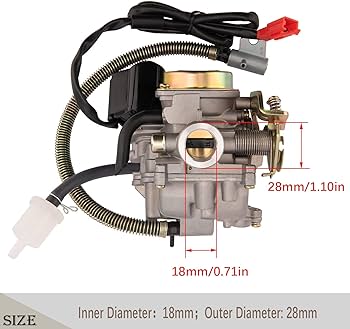Sputtering at wide open throttle is often caused by a fuel or ignition issue. This problem can be a result of issues with the fuel pump, fuel injectors, or spark plugs.
It can also be due to a clogged air filter or a faulty oxygen sensor. The symptoms of sputtering at wide open throttle may include hesitation, misfiring, or loss of power. It’s important to address these issues promptly to avoid further damage to the engine and to ensure optimal vehicle performance.
Regular maintenance and timely diagnosis of any irregularities can help prevent sputtering at wide open throttle and keep your vehicle running smoothly.
Contents
Troubleshooting Sputtering At Wide Open Throttle
Sputtering at wide open throttle can be a frustrating issue for car owners, leading to a noticeable loss in power and performance. Identifying and resolving the causes of this problem are crucial to ensure the smooth operation of the vehicle. In this article, we will discuss how to troubleshoot sputtering at wide open throttle, understanding the symptoms, identifying common causes, and the role of engine diagnostics in resolving this issue.
Understanding The Symptoms
When experiencing sputtering at wide open throttle, it’s essential to be aware of the associated symptoms. Common signs include:
- Intermittent loss of power during acceleration
- Irritating jerking or hesitation while driving at high speeds
- Unusual engine noise or vibration
Identifying Common Causes
There are several common causes that can lead to sputtering at wide open throttle. These may include:
- Fuel delivery issues such as a clogged fuel filter or failing fuel pump
- Ignition system problems like worn spark plugs or a malfunctioning ignition coil
- Air intake restrictions due to a dirty air filter or a faulty mass airflow sensor
The Role Of Engine Diagnostics
In addressing sputtering at wide open throttle, the utilization of engine diagnostics becomes integral. Advanced diagnostic tools and software can help pinpoint the specific problem areas within the engine and fuel systems, enabling swift and efficient resolution.

Identifying Sputtering Symptoms
Signs During Acceleration
When experiencing sputtering at wide open throttle, pay attention to signs during acceleration. Look for hesitation, jerking, or a feeling of misfiring when pressing the gas pedal heavily. The vehicle may exhibit a lack of power or struggle to maintain speed, indicating an issue with fuel delivery, ignition, or air intake.
Comparative Engine Performance
Comparing the engine’s performance to its usual state can help identify sputtering. Notice any sudden changes in fuel efficiency, power output, or responsiveness. An engine that normally runs smoothly but exhibits irregular performance at wide open throttle may be sputtering due to an underlying problem.
Audio Cues From The Engine
Listen for specific audio cues from the engine that could indicate sputtering. Popping or backfiring noises, irregular revving, or a rough idle at normal operating temperatures might signify issues with fuel or ignition systems. These audio symptoms can help pinpoint the source of the sputtering problem, leading to a more accurate diagnosis and effective repairs.
Common Causes Of Throttle Sputter
Sputtering at wide open throttle can be frustrating for any driver. It can cause a lack of power, hesitation, and potential damage to the engine if not addressed. In this article, we will discuss the common causes of throttle sputter and how to diagnose and resolve these issues.
Fuel System Malfunctions
When fuel system malfunctions occur, it can disrupt the proper flow of fuel to the engine, leading to sputtering. Common issues include clogged fuel filters, a failing fuel pump, or dirty fuel injectors. These problems can result in a lean or rich fuel mixture, causing the engine to sputter and lose power.
Ignition System Inconsistencies
Ignition system inconsistencies can also lead to throttle sputter. This can be caused by faulty spark plugs, a malfunctioning ignition coil, or a worn-out distributor cap. When the ignition system is not functioning properly, it can result in misfires, leading to sputtering and a lack of power.
Intake And Exhaust Blockages
Intake and exhaust blockages can restrict the flow of air and exhaust gases, causing the engine to sputter. Common issues include a clogged air filter, a blocked catalytic converter, or a damaged exhaust manifold. When the intake and exhaust systems are blocked, the engine cannot breathe properly, leading to sputtering and reduced performance.
Diagnosing Sputtering Engines
Diagnosing sputtering engines can be a frustrating experience for any vehicle owner or mechanic. Sputtering can occur for a variety of reasons, ranging from inadequate fuel delivery to ignition system malfunctions. Identifying the root cause of the issue is key to resolving engine sputtering and restoring optimal performance. In this section, we will explore the step-by-step diagnostic approach to diagnosing sputtering engines, how to effectively use OBD-II scanners, and reading and interpreting error codes.
Step-by-step Diagnostic Approach
When dealing with a sputtering engine, a systematic diagnostic approach is essential to pinpoint the underlying problem. Here are the key steps to take:
- Check for any visible signs of damage or wear in the ignition system components, such as spark plugs, ignition coils, and spark plug wires.
- Inspect the fuel system, including the fuel filter, fuel injectors, and fuel pump, for any blockages or malfunctions.
- Examine the air intake system for any obstructions or leaks, which can lead to inadequate air supply to the engine.
- Conduct a thorough examination of the engine’s electronic control system, including sensors and actuators, to detect any faulty components.
- Test the vehicle under load conditions to observe the sputtering behavior and gather additional diagnostic data.
How To Use Obd-ii Scanners
Utilizing an OBD-II scanner is an efficient way to gather diagnostic information from the vehicle’s onboard computer. Here’s how to effectively use an OBD-II scanner:
- Locate the OBD-II port in the vehicle, typically located under the dashboard on the driver’s side.
- Plug the OBD-II scanner into the port and turn the vehicle’s ignition key to the “on” position without starting the engine.
- Follow the instructions provided with the OBD-II scanner to retrieve diagnostic trouble codes (DTCs) and other relevant data from the vehicle’s computer.
- Record the retrieved DTCs and any freeze frame data for further analysis and troubleshooting.
Reading And Interpreting Error Codes
Understanding the error codes retrieved from the OBD-II scanner is crucial to diagnosing and addressing sputtering issues. Here’s how to read and interpret the error codes:
- Refer to the OBD-II scanner’s user manual or online resources to decode the retrieved DTCs specific to the vehicle’s make and model.
- Identify the meaning and potential causes associated with each error code to determine the most likely sources of the sputtering problem.
- Use the interpreted error codes as a guide to narrow down diagnostic investigations and develop a targeted repair plan to resolve the sputtering issue.
Sputtering Solutions And Maintenance
Experiencing sputtering at wide open throttle can be a frustrating and concerning issue for any vehicle owner. Sputtering often indicates a problem with the engine, leading to decreased power and performance. Fortunately, there are effective sputtering solutions and maintenance practices that can help resolve this issue and keep your vehicle running smoothly.
Repair And Replacement Advice
When faced with sputtering at wide open throttle, it’s essential to diagnose the root cause of the problem. Possible culprits include issues with the fuel system, ignition system, or engine components. Inspect the spark plugs, fuel injectors, and air filters for any signs of wear or malfunction. If any components are found to be faulty, prompt repair or replacement is crucial to restore optimal engine performance.
Preventative Measures
Preventing sputtering at wide open throttle involves proactive measures to maintain the health of your vehicle’s engine. Regularly cleaning or replacing fuel filters and air filters can help prevent build-up of debris and contaminants that may cause sputtering. Additionally, using high-quality fuel and oil can minimize the risk of clogs or deteriorated engine lubrication, reducing the likelihood of sputtering.
Regular Maintenance For Optimal Performance
Performing routine maintenance tasks can greatly contribute to preventing sputtering at wide open throttle. This includes scheduled spark plug replacements, fuel system cleanings, and ignition system inspections. Regularly checking and maintaining these crucial components ensures that your vehicle’s engine operates at its best, minimizing the risk of sputtering and maintaining smooth acceleration.
Frequently Asked Questions
What Causes Sputtering At Wide Open Throttle?
A sputtering engine at wide open throttle can be caused by issues with the fuel system, ignition system, or engine compression. It is important to diagnose the specific cause to address the issue effectively and prevent further damage to the vehicle.
How Can I Diagnose Sputtering During Acceleration?
Diagnosing sputtering during acceleration involves checking the fuel system, ignition system, and engine compression. Use a fuel pressure gauge, spark tester, and compression tester to determine the underlying cause and take necessary action to resolve the issue.
Why Does My Car Sputter When I Floor It?
Your car may sputter when you floor it due to issues with the fuel system such as clogged fuel injectors or a failing fuel pump. Ignition system problems or engine misfires can also contribute to this issue. Proper diagnosis is crucial for effective resolution.
Can A Clogged Fuel Filter Cause Sputtering?
Yes, a clogged fuel filter can cause sputtering as it restricts the flow of fuel to the engine, leading to fuel starvation during acceleration. Regularly replacing the fuel filter according to the manufacturer’s recommendations can help prevent this issue and maintain optimal engine performance.
Final Thoughts
Understanding the causes of sputtering at wide open throttle is essential for maintaining optimal engine performance. Regular maintenance and prompt diagnostics can prevent potential issues. By addressing these concerns, drivers can enjoy a smoother driving experience and extend the lifespan of their vehicles.
Stay informed and proactive to avoid potential sputtering problems down the road.


